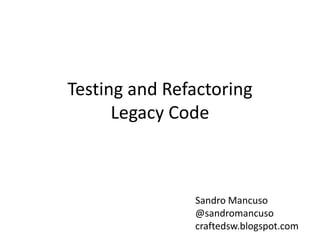
Legacy Code Hands-on Session
- 1. Testing and Refactoring Legacy Code Sandro Mancuso @sandromancuso craftedsw.blogspot.com
- 2. What is this session about?
- 3. Business Requirements Imagine a social networking website for travellers • You need to be logged in to see the content • You need to be a friend to see someone else’s trips
- 4. Legacy Code Rules • You cannot change production code if not covered by tests – Just automated refactorings (via IDEs) are allowed, if needed to write the test
- 5. Tips • Use a code coverage tool • Commit as often as possible – Enables you to commit (push) improvements quickly – Allows you to roll back (reset) if you get lost • When refactoring, try to stay in the green for as long as possible
- 6. Exercise
- 7. Working with Legacy Code Tips Start refactoring from deepest to shortest branch Start testing from shortest to deepest branch
- 8. Trip Service - Problems <<Singleton>> UserSession +getInstance() : UserSession +getLoggedUser() : User TripService +findTripsByUser(User) : List<Trip> TripDAO +findTripsByUser(User) : List<Trip>
- 9. Legacy Code Common Problems • Hard-wired dependencies – Create a “seam” to break dependencies • Extract dependency in a protected method • In our test, extend the class under test and override the method with the dependency so you can mock the result • Identify feature envy – Move behaviour out to the appropriate class
- 10. Exercise
- 11. Remember Start refactoring from deepest to shortest branch Start testing from shortest to deepest branch
- 12. Refactoring vs Re-design • After localised refactoring, consider fixing the design • Writing tests for existing code may perpetuate a bad design
- 13. Craftsmen at work • Write readable and maintainable code – Code must express business rules • Strive for simplicity • Know your tools well (i.e. frameworks, shortcuts) • Work in small and safe increments – Commit often • Embrace changes, be brave • Boy scout rule / No broken windows
- 14. Thanks https://github.com/sandromancuso/trip-service-kata Sandro Mancuso @sandromancuso craftedsw.blogspot.com
